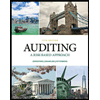
Accounting Information Systems
11th Edition
ISBN: 9780357156032
Author: Ulric J. Gelinas; Richard B. Dull; Patrick Wheeler
Publisher: Cengage Limited
expand_more
expand_more
format_list_bulleted
Question
Chapter 12, Problem 6RQ
Summary Introduction
To describe: The five basic components of the Supply Chain Operations Reference (SCOR) model.
Introduction:
Expert Solution & Answer
Trending nowThis is a popular solution!

Students have asked these similar questions
What is an annuity?*
An investment that has no definite end and a stream of cash payments that continues forever
A stream of cash flows that start one year from today and continue while growing by a constant growth rate
A series of equal payments at equal time periods and guaranteed for a fixed number of years
A series of unequal payments at equal time periods which are guaranteed for a fixed number of years
If you were able to earn interest at 3% and you started with $100, how much would you have after 3 years?*
$91.51
$109.27
$291.26
$103.00
No AI
2. The formula for calculating future value (FV) is*
FV = PV/(1+r)^n
FV = PV/(1+r)*n
FV = PV x (1+r)^n
FV = PV x (1+r)*n
Chapter 12 Solutions
Accounting Information Systems
Ch. 12 - Prob. 1RQCh. 12 - What primary functions does the purchasing process...Ch. 12 - Prob. 3RQCh. 12 - What are the fundamental responsibilities of each...Ch. 12 - Describe supply chain management (SCM).Ch. 12 - Prob. 6RQCh. 12 - Prob. 7RQCh. 12 - Prob. 8RQCh. 12 - Prob. 9RQCh. 12 - Prob. 10RQ
Ch. 12 - Prob. 11RQCh. 12 - What types of frauds are typically found in the...Ch. 12 - What are the typical effectiveness goals of the...Ch. 12 - What characterizes a valid PO input? What...Ch. 12 - Prob. 15RQCh. 12 - Describe the impact that entity-level controls...Ch. 12 - Refer to the operations process (effectiveness)...Ch. 12 - Explain why ambiguities and conflicts exist among...Ch. 12 - Prob. 3DQCh. 12 - Without redrawing the figures, discuss how Figure...Ch. 12 - Prob. 5DQCh. 12 - Prob. 6DQCh. 12 - Prob. 7DQCh. 12 - Prob. 8DQCh. 12 - Prob. 9DQCh. 12 - Prob. 1SPCh. 12 - Prob. 2SPCh. 12 - Prob. 3SPCh. 12 - Prob. 4SPCh. 12 - Prob. 4PCh. 12 - Prob. 5PCh. 12 - Prob. 6P
Knowledge Booster
Similar questions
- Calculate Value of R??arrow_forwardHello tutor need barrow_forwardMoose Enterprises finds it is necessary to determine its marginal cost of capital. Moose’s current capital structure calls for 50 percent debt, 30 percent preferred stock, and 20 percent common equity. Initially, common equity will be in the form of retained earnings (Ke) and then new common stock (Kn). The costs of the various sources of financing are as follows: debt, 9.6 percent; preferred stock, 9 percent; retained earnings, 10 percent; and new common stock, 11.2 percent. a. What is the initial weighted average cost of capital? (Include debt, preferred stock, and common equity in the form of retained earnings, Ke.) b. If the firm has $18 million in retained earnings, at what size capital structure will the firm run out of retained earnings? c. What will the marginal cost of capital be immediately after that point? (Equity will remain at 20 percent of the capital structure, but will all be in the form of new common stock, Kn.) d. The 9.6 percent cost of debt referred to earlier…arrow_forward
- 7. Berkeley Farms wants to determine the minimum cost of capital point for the firm. Assume it is considering the following financial plans: Cost (aftertax) Weights Plan A Debt .................................. 4.0% 30% Preferred stock .................. 8.0 15 Common equity ................. 12.0 55 Plan B Debt .................................. 4.5% 40% Preferred stock .................. 8.5 15 Common equity ................. 13.0 45 Plan C Debt .................................. 5.0% 45% Preferred stock .................. 18.7 15 Common equity ................. 12.8 40 Plan D Debt .................................. 12.0% 50% Preferred stock .................. 19.2 15 Common equity ................. 14.5 35 a. Which of the four plans has the lowest weighted average cost of capital? Use the Kd (cost of debt) = Y(1 - T), Kp (Cost of preferred stock) = Dp/Pp - F, Ke = D1/P0 + g formulas or I will not understand.arrow_forwardNeed use the Kd (cost of debt) = Y(1 - T), Kp (Cost of preferred stock) = Dp/Pp - F, Ke = D1/P0 + g formulas or I will not understand. Delta Corporation has the following capital structure: Cost Weighted (after-tax) Weights Cost Debt 8.1% 35% 2.84% Preferred stock (Kp) 9.6 5 .48 Common equity (Ke) (retained earnings) 10.1 60 6.06 Weighted average cost of capital (Ka) 9.38% a. If the firm has $18…arrow_forwardDelta Corporation has the following capital structure: Cost Weighted (after-tax) Weights Cost Debt 8.1% 35% 2.84% Preferred stock (Kp) 9.6 5 .48 Common equity (Ke) (retained earnings) 10.1 60 6.06 Weighted average cost of capital (Ka) 9.38% a. If the firm has $18 million in retained earnings, at what size capital structure will the firm run out of retained earnings? b. The 8.1 percent cost of…arrow_forward
arrow_back_ios
SEE MORE QUESTIONS
arrow_forward_ios
Recommended textbooks for you
 EBK CONTEMPORARY FINANCIAL MANAGEMENTFinanceISBN:9781337514835Author:MOYERPublisher:CENGAGE LEARNING - CONSIGNMENT
EBK CONTEMPORARY FINANCIAL MANAGEMENTFinanceISBN:9781337514835Author:MOYERPublisher:CENGAGE LEARNING - CONSIGNMENT Auditing: A Risk Based-Approach (MindTap Course L...AccountingISBN:9781337619455Author:Karla M Johnstone, Audrey A. Gramling, Larry E. RittenbergPublisher:Cengage Learning
Auditing: A Risk Based-Approach (MindTap Course L...AccountingISBN:9781337619455Author:Karla M Johnstone, Audrey A. Gramling, Larry E. RittenbergPublisher:Cengage Learning Intermediate Financial Management (MindTap Course...FinanceISBN:9781337395083Author:Eugene F. Brigham, Phillip R. DavesPublisher:Cengage Learning
Intermediate Financial Management (MindTap Course...FinanceISBN:9781337395083Author:Eugene F. Brigham, Phillip R. DavesPublisher:Cengage Learning

EBK CONTEMPORARY FINANCIAL MANAGEMENT
Finance
ISBN:9781337514835
Author:MOYER
Publisher:CENGAGE LEARNING - CONSIGNMENT

Auditing: A Risk Based-Approach (MindTap Course L...
Accounting
ISBN:9781337619455
Author:Karla M Johnstone, Audrey A. Gramling, Larry E. Rittenberg
Publisher:Cengage Learning

Intermediate Financial Management (MindTap Course...
Finance
ISBN:9781337395083
Author:Eugene F. Brigham, Phillip R. Daves
Publisher:Cengage Learning
